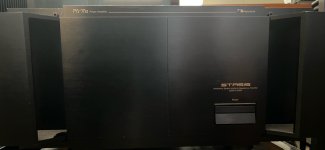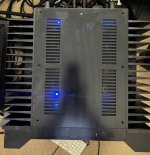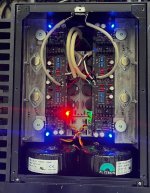Very nice build Berny!
+/-30V rails give you just a few more watts of heat from the big mosfets. No issue at all.
Cheers,
Dennis
+/-30V rails give you just a few more watts of heat from the big mosfets. No issue at all.
Cheers,
Dennis
Thanks. Indeed, so I dont know if I shoud slightly adapt their voltage reference as discribed in the building guide or not. It is just borderline....Very nice build Berny!
+/-30V rails give you just a few more watts of heat from the big mosfets. No issue at all.
Cheers,
Dennis
OK, I just took a couple of pictures of my version of this great amp.
I added a "T" Plate under the Store board so I could double up on output devices (you can barely see it in the last picture.) Just paralleled the outputs after matching them, with separate grid resistors for each device. I made no other changes to accommodate the second pair per channel.
I am running at 28 volt rails and 2 volts across the .1 ohm resistor.
I think this doubles the damping factor, probably adds more feedback too.
It sounds great, one of the best sounding amps I have. (I have Mr Pass' Factory F7 to compare, among other DIY amps from the master.)
Just a note about the case. I found a cheap Nakamichi PA-7AII that had a bad channel, gutted it and built the Pass/Sony VFET inside. The heatsinks are massive. (I hope the irony is not lost, using a Stasis amp box to house a later Nelson Pass design.)
I need to wipe the old lettering off the faceplate and label it what it is: "Greatest Amp Ever" or "Pass/Sony VFET PP"
Rush
I added a "T" Plate under the Store board so I could double up on output devices (you can barely see it in the last picture.) Just paralleled the outputs after matching them, with separate grid resistors for each device. I made no other changes to accommodate the second pair per channel.
I am running at 28 volt rails and 2 volts across the .1 ohm resistor.
I think this doubles the damping factor, probably adds more feedback too.
It sounds great, one of the best sounding amps I have. (I have Mr Pass' Factory F7 to compare, among other DIY amps from the master.)
Just a note about the case. I found a cheap Nakamichi PA-7AII that had a bad channel, gutted it and built the Pass/Sony VFET inside. The heatsinks are massive. (I hope the irony is not lost, using a Stasis amp box to house a later Nelson Pass design.)
I need to wipe the old lettering off the faceplate and label it what it is: "Greatest Amp Ever" or "Pass/Sony VFET PP"
Rush
Attachments
That's really nice Rush.
Even with the double output devices, I imagine the heatsinks are still quite cool?
Cheers,
Dennis
Even with the double output devices, I imagine the heatsinks are still quite cool?
Cheers,
Dennis
Thank you.
No, the heatsinks are quite hot! I can barely keep my hands on them for 5 seconds.
Rush
No, the heatsinks are quite hot! I can barely keep my hands on them for 5 seconds.
Rush
Yeah, I guess it is probably over 120W per side.
BTW, it's always nice to see Plitron transformers, especially since the brand is now gone.
BTW, it's always nice to see Plitron transformers, especially since the brand is now gone.
All nice builds, Cody, Bernie, Dennis, and Rush!
More than five years after introduction, they are still coming out of hiding. I wonder how many kits are out there still unbuilt? 🙂
More than five years after introduction, they are still coming out of hiding. I wonder how many kits are out there still unbuilt? 🙂
Pass DIY Addict
Joined 2000
Paid Member
Agreed, some nice implementations showing up lately! I have 2 kits, but only built one of them so far. The one that I did build was just last year, so it was 4 years late…
Yeah, lots of nice builds showing up here - great job everyone! It really is a superb amp, so I suppose it only makes sense 🙂
Yes, I can confirm that 🙂My everyday amp! Serious reference, haven't heard anything better yet!
For the record, the BC550 and BC560 are functionally equivalent to the ZTX 450 and 550, and would work perfectly, they merely have a different pinout. This is very simple to work around.
Last edited:
Well I might have done it now.
My wife and I moved last year and I've been meaning to check the bias on my VFET amp since it surely bounced around a lot in the moving truck. After listening to it this morning I decided to go ahead and check it. Tweaked the left channel fine and when I was tweaking the right channel I turned the wrong pot. I stopped, turned it off, and decided to start from square one. I turned pots P3 and P4 counterclockwise, turned on and checked bias on the output (T16 and T17). I then started to bias the front end and noticed the right side heat sink and VFETs are cold compared to the left side.
I'm not sure what to do now. I assume the output stage should be generating heat even without the front end biased. I didn't hear or smell anything fry so hopefully the magic smoke is intact.
Any help would be appreciated.
My wife and I moved last year and I've been meaning to check the bias on my VFET amp since it surely bounced around a lot in the moving truck. After listening to it this morning I decided to go ahead and check it. Tweaked the left channel fine and when I was tweaking the right channel I turned the wrong pot. I stopped, turned it off, and decided to start from square one. I turned pots P3 and P4 counterclockwise, turned on and checked bias on the output (T16 and T17). I then started to bias the front end and noticed the right side heat sink and VFETs are cold compared to the left side.
I'm not sure what to do now. I assume the output stage should be generating heat even without the front end biased. I didn't hear or smell anything fry so hopefully the magic smoke is intact.
Any help would be appreciated.
Thanks for the nudge Dennis. Since there was a voltage on R32 I figured it wasn't toast. I went ahead and slowly brought everything up to bias and everything seems normal. Going to let it run tomorrow and check again and hook up a cheap speaker.
Phew, I was sweating bullets.
Phew, I was sweating bullets.
I am organizing my build. My first question is does anybody have an opinion as to which approach might give the best audio result. The linear PS approach or the new SMPS approach (with something like Theseus).
Thanks,
Don
Thanks,
Don
Don, I don't recall seeing this dual rail vfet amp built with SMPS power supplies. Perhaps you're thinking of the more recent single rail projects?
- Home
- Amplifiers
- Pass Labs
- Sony vFET Illustrated build guide



